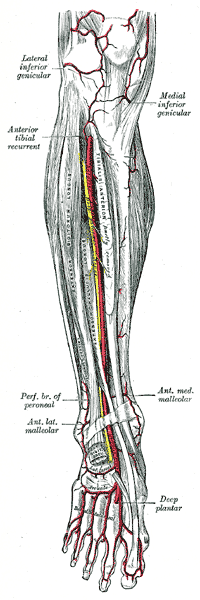Arcuate artery of the foot
Arcuate Artery of the Foot[edit | edit source]
The arcuate artery of the foot is a significant artery located in the dorsum of the foot. It plays a crucial role in the blood supply to the toes and the metatarsal bones.
Anatomy[edit | edit source]
The arcuate artery is a branch of the dorsalis pedis artery, which itself is a continuation of the anterior tibial artery. The dorsalis pedis artery travels along the top of the foot and gives rise to the arcuate artery.
The arcuate artery runs laterally across the bases of the metatarsal bones, beneath the tendons of the extensor digitorum brevis muscle. It is located superficial to the dorsal interossei muscles.
Branches[edit | edit source]
The arcuate artery gives off several dorsal metatarsal arteries, which further divide into the dorsal digital arteries supplying the toes. These branches ensure adequate blood flow to the phalanges and the dorsal aspect of the foot.
Clinical Significance[edit | edit source]
The arcuate artery is important in clinical assessments of peripheral circulation in the foot. It can be palpated in some individuals, and its pulse is an indicator of vascular health.
In cases of peripheral artery disease, the blood flow through the arcuate artery may be compromised, leading to symptoms such as claudication or ischemia in the foot.
Variations[edit | edit source]
There can be anatomical variations in the presence and course of the arcuate artery. In some individuals, the artery may be absent or replaced by an enlarged lateral tarsal artery.
Related Pages[edit | edit source]
Search WikiMD
Ad.Tired of being Overweight? Try W8MD's NYC physician weight loss.
Semaglutide (Ozempic / Wegovy and Tirzepatide (Mounjaro / Zepbound) available. Call 718 946 5500.
Advertise on WikiMD
|
WikiMD's Wellness Encyclopedia |
| Let Food Be Thy Medicine Medicine Thy Food - Hippocrates |
Translate this page: - East Asian
中文,
日本,
한국어,
South Asian
हिन्दी,
தமிழ்,
తెలుగు,
Urdu,
ಕನ್ನಡ,
Southeast Asian
Indonesian,
Vietnamese,
Thai,
မြန်မာဘာသာ,
বাংলা
European
español,
Deutsch,
français,
Greek,
português do Brasil,
polski,
română,
русский,
Nederlands,
norsk,
svenska,
suomi,
Italian
Middle Eastern & African
عربى,
Turkish,
Persian,
Hebrew,
Afrikaans,
isiZulu,
Kiswahili,
Other
Bulgarian,
Hungarian,
Czech,
Swedish,
മലയാളം,
मराठी,
ਪੰਜਾਬੀ,
ગુજરાતી,
Portuguese,
Ukrainian
Medical Disclaimer: WikiMD is not a substitute for professional medical advice. The information on WikiMD is provided as an information resource only, may be incorrect, outdated or misleading, and is not to be used or relied on for any diagnostic or treatment purposes. Please consult your health care provider before making any healthcare decisions or for guidance about a specific medical condition. WikiMD expressly disclaims responsibility, and shall have no liability, for any damages, loss, injury, or liability whatsoever suffered as a result of your reliance on the information contained in this site. By visiting this site you agree to the foregoing terms and conditions, which may from time to time be changed or supplemented by WikiMD. If you do not agree to the foregoing terms and conditions, you should not enter or use this site. See full disclaimer.
Credits:Most images are courtesy of Wikimedia commons, and templates, categories Wikipedia, licensed under CC BY SA or similar.
Contributors: Prab R. Tumpati, MD

